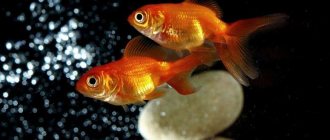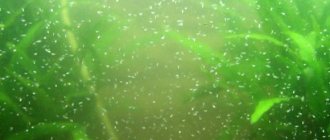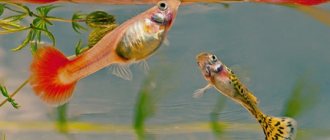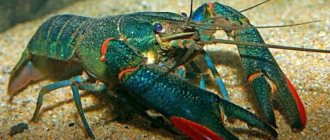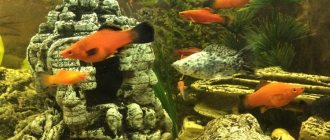Fish, which inhabit almost all types of water bodies, are characterized by the greatest variety of reproduction methods among animals. Over a huge period - more than 400 million years, fish have mastered reservoirs with fresh and salt water; they live at various depths, in high-mountain and underground reservoirs, in rivers and streams with fast currents and in stagnant silted floodplains and swamps. The environment and living conditions require adaptation for the survival of not only adult individuals, but also for maximum preservation of offspring. From this point of view, it is very interesting to get acquainted with the facts of how fish reproduce and what this gave to each species.
How do fish reproduce?
There are monogamous and polygamous, responsible parents and caviar-eating pets.
Sexual method
Sexual reproduction predominates in aquarium fish. Methods for fertilizing eggs:
- Interior. Insemination occurs in the body. Characteristic for viviparous women.
- Outer. The eggs are fertilized in the pond. Refers to spawn-laying.
Depending on the development of eggs, there are three types:
- Viviparous. Development and gestation occurs inside the mother. The embryos feed directly from the mother's body. Breeding is easy due to the high survival rate of the offspring.
- Ovoviviparous. The fertilized eggs are attached to the posterior part of the oviduct. Difference from viviparity - the offspring are separated from the mother's metabolism, nutrition occurs from the contents of the yolk. The mother's body serves only to protect against external threats.
- Egg-laying (oviparous). Deposition of eggs in water.
Parthenogenesis
Parthenogenesis means the development of eggs without fertilization by a male. Rarely found in aquarium conditions. From the eggs, male and female individuals emerge, which over time regulates the numerical ratio of the sexes. This type of reproduction occurs in cyprinids, as well as commercial fish. Unfertilized eggs are adjacent to fertilized ones. Viable offspring rarely appear. Parthenogenesis is a sexual method of reproduction, since germ cells are involved, but gamete fusion does not occur.
Gynogenesis
Males and females of different species participate. As with parthenogenesis, the eggs are not fertilized. The male activates the spawning process. Offspring are born only female.
Hermaphroditism
The presence of male and female characteristics, manifested sequentially or simultaneously. Hermaphroditism includes changing sex during life or laying eggs and fertilization by one fish.
How do fish care for their offspring?
Caring for the offspring usually comes down to ensuring the safety of the eggs. It is either deposited in a place most inaccessible to predators, or, if possible, protected from them by its parents. At one time, the female lays several thousand eggs. But only a few fry will be able to hatch and grow.
Interesting materials:
What are Zonal natural complexes? What is sound in speech? What is ozone? What is a director? What does it mean if the discriminant is negative? What does it mean if a cat lies on its head? What does it mean if a cat growls at a person? What does it mean if lymphocytes are below normal? What does it mean if you find a ring? What does it mean if the parcel has been handed over to the carrier?
Types of fish
Viviparous
The fish are unpretentious and hardy, and can be easily bred by aquarists. To start spawning, there is no need for frequent water changes and changes in diet - the reproduction process begins by itself. The offspring are completely independent. Viviparous animals lack parental instincts. This group included:
- guppy;
- swordtails;
- mollies;
- platies;
- Gambusia;
- four-eyed fish;
- Formosa.
Spawn-marking
Females lay eggs, and males fertilize them. Fish have learned to hide their offspring from others under plant leaves, in rocks and caves, and in shells.
Creating comfortable conditions for successful fish breeding
Before breeding goldfish, the spawning tank must be properly prepared and all favorable conditions must be created for subsequent spawning. First, a small number of plants with small leaves should be placed in the container that is intended to be used for propagation. For placement in the spawning tank, you can use plants such as hornwort, or for example, elodea. It is best to press all plants to the bottom of the container with a small weight.
Hornwort is a win-win option for landscaping spawning grounds.
In a spawning tank used for breeding and raising goldfish fry, instead of plants, you can alternatively place small bundles of finely plucked loofah. It should be noted that willow sponges cannot be used. Bunches of loofah are placed in the container in the same way as plants. Egg-laying fish, which include goldfish, unlike viviparous fish (for example, platies), do not give birth to live fry. They lay eggs, which adhere to plants or the surface of tufts of loofah. When a pregnant goldfish has spawned all its eggs, they can be removed from the spawning tank.
Some breeders use synthetic sponge fibers for spawning.
In addition, when breeding goldfish in a spawning area, you need to create comfortable conditions for spawning. To do this, you need to carefully monitor:
- water temperature;
- water filtration system and its oxygen saturation level;
- aquarium lighting.
The optimal water temperature inside the spawning tank in which it is planned to breed fish should not exceed + 28 degrees Celsius . To select the optimal water temperature for comfortable life and reproduction of goldfish, it is necessary, first of all, to pay special attention to the length of their body.
For example, in the case when the body of the fish has a long shape, then the optimal water temperature for it is no less than +15 and no more than +25 degrees Celsius. However, if the body of the fish is short, then in this case, the water temperature for its normal life and reproduction should be about 22-28 degrees Celsius.
When breeding goldfish yourself, it is recommended to pay attention to the seasonality of changes in water temperature. Simply put, in summer, the water in the spawning area should be slightly warmer than the recommended minimum value, and in winter, on the contrary, lower. Also, the water in the container in which the fish are kept must be constantly saturated with oxygen. A lack of oxygen in the water can cause oxygen starvation in fish, which can cause them to die.
Onset of puberty
Development happens:
- direct;
- indirect.
Direct is characterized by a similar structure of fry and adult fish. Indirect development occurs with transformations: the born individual does not resemble its parents. Those that lay eggs are characterized by an indirect type of development.
To have a similar structure to adult individuals, the offspring go through several stages:
- An embryo is formed inside the egg.
- After passing through the embryonic stage of development, the future fry enters the larval stage. It begins with a rupture of the egg membrane. The larva has large eyes and an elongated body without fins. In the first few days the larva is motionless.
- The whitebait visually resembles a smaller copy of an adult fish. Scales and fins appear.
- Gradually the fry grows to adulthood.
Viviparous species produce independent and structurally similar offspring - fry. This is a direct development.
Fish with a short life cycle become ready to reproduce earlier. Already at the age of 2 months, the fish is ready to reproduce. In small cichlids - at 3 months. Large fish with a long lifespan develop by 4-5 years. There are species that mature in 15-30 years. Males reach puberty earlier than females.
Caring for fry
Raising young animals is much more difficult than caring for adults. For the first food, small ciliates or daphnia are suitable. Around the fifth day, you can give small Artemia crustaceans; you can hatch them yourself or buy them at a pet store. You should not feed your fish egg yolk, it quickly deteriorates and becomes covered with fungus, which affects the water parameters.
The fry need to be given food five times a day, at regular intervals. It is very important to carefully remove food debris from the bottom using a small siphon.
On the fifth day, you can install a small filter, this will help regulate the purity of the water. Just to prevent the fry from being sucked into it, first wrap the filter with a thin cloth or nylon stocking.
After about a month, the fish will acquire the shape characteristic of angelfish and will gradually begin to eat crushed food for adults.
After a few more weeks, you can place the grown young fish in a community aquarium or start looking for a new home for the fish. In many pet stores you can exchange healthy young fish for food or necessary equipment.
Reproduction of viviparous
Livebearers spawn several times a year without creating special conditions. If spawning does not occur, gradually increase the temperature a couple of degrees. Pregnancy proceeds faster at elevated temperatures, but too warm water will result in non-viable offspring.
During the incubation period, the female's abdomen will grow and become noticeably rounder, and when it becomes more square, place the expectant mother for a quiet birth.
Keep the offspring separate from the adults, otherwise the fry will be eaten.
Prepare a separate aquarium or a special trap for breeding aquarium fish. After two weeks, the first sexual signs appear. Sort the fry by sex: individuals with a dark spot on the abdomen are females.
Temperature and water changes
To stimulate, the water temperature should be increased to 28° C; in fish, at the genetic level, this will be an indicator of the beginning of the warm season and the time of spawning. In nature, it is with the onset of warmth that young individuals begin to break into pairs and lay eggs.
You will also need to regularly do water changes 3-4 times a week, replacing approximately 10% of the total volume. It is important that distilled or pre-boiled water must be added to reduce its hardness. And the temperature should be close to the one in which the pets are used to living.
Reproduction of spawners
Spawners spawn in different ways. Some species form pairs, others form harems or flocks. The spawning tank is prepared in accordance with the characteristics of the producers.
Dispersal of eggs
Dispersal occurs during school spawning. The eggs scatter randomly and fall onto the ground, leaves and stones. Adult fish do not show parental affection and eat the eggs. To protect the eggs, place the soil in the form of balls with a diameter of 1 cm, cover the bottom with a mesh with small cells.
Masonry formation
The pair form a clutch in a secluded place. The eggs are carefully cared for and protected. Place shelters and broad-leaved plants in the spawning aquarium, where it will be convenient to spawn.
Formation of masonry in caves and gorges
This behavior is typical for fish emerging from aggressive habitat conditions. The spawning ground is equipped with shelters made from piles of rocks, large shells and pots.
Immersion of eggs in the ground
Killie fish, coming from shallow reservoirs with muddy bottoms, form temporary pairs. Pay attention to the soil, choose a substrate based on peat or coconut fibers. Once the parents have spawned the eggs, they can be stored for a couple of months in a warm, dry place. This feature is used when sending eggs by mail.
Nest of bubbles
Labyrinthine fish build nests from air bubbles and pieces of plants. Parents form pairs for life and carefully care for the eggs until the fry appear. When decorating a spawning container, place tall and floating plants. It is imperative to have a tight lid in which an air gap is formed.
Caviar with parents
You can place the pair along with the eggs in a separate aquarium, then the fry will have a greater chance of hatching. Parental care is very important for the health of small fish, but difficulties may arise during transplantation:
- Additional aquarium. Few aquarists, especially beginners, can boast of having another tank with a volume of 50–80 liters. And in a smaller volume of water, two large fish will not feel comfortable and care for their offspring.
- The water parameters in a new aquarium should correspond as closely as possible to the water in general. It is optimal to take 30–40 percent of the water from the general aquarium, and add the rest of the volume with distilled or boiled water.
- Adult fish may react poorly to being moved to a new location and may stop caring for the eggs.
Peculiarities of reproduction of popular fish
Fish reproduction is accompanied by interesting features:
- Some fish care for their offspring during the egg stage. Then their parental instincts fade away.
- Male cichlids, on the contrary, are overly worried about the offspring and show aggression towards females if they don’t like something in the treatment of the offspring.
- A sharp change in conditions in viviparous fish leads to a change in sex from female to male.
- Discus fish, angelfish and fairy cichlids take a long time to choose a partner for mating and form a pair for life.
In fact
Although parental care is extremely important for the development of small fish, adult fish do not provide as much care. Even if you place the selected pair in a separate aquarium, there will be no guarantee that the parents will care for the eggs. This is especially true for young individuals.
And angelfish (fry) simply have no chance of hatching from eggs in a community aquarium without outside help. At best, the couple will try to protect the eggs for the first two days. But the stress from spawning and the interference of voracious neighbors leads to the fact that some of the offspring will be eaten and the rest will disappear.
It happens that when darkness falls, the parents themselves get lost and eat the recently laid eggs.
There are several options for what to do with angelfish eggs in a community aquarium. You can leave everything as is, then the pets will receive an additional portion of food, and the pair will be ready for the next spawning in about a month.
And those who set out to raise a school of small fish have two options: place the parents together with the eggs, or equip a small aquarium and turn into a nanny for a while.
Problems
- Breed aquarium fish responsibly. Create conditions for future fish in advance. Calculate how much aquarium volume you will need. Often, due to incorrect calculations or too many offspring, fish suffer from overpopulation. When there is not enough space, the fish become aggressive towards each other and experience stress. In an overcrowded tank, the fish grow smaller in size, which leads to subsequent health problems.
- Another problem is that the fry do not survive to the teenage stage. The death of fry is caused by improper selection of food and poor water quality. Remember that there should be no large particles of food in the container with the fry.
- Avoid inbreeding. Population degeneration occurs due to heterosexual offspring not separated in time. The fish look less bright and may have problems with further self-reproduction. The same applies to closely related species (swordtails, mollies, platies).
- If the necessary conditions are created, and the fish do not reproduce or lay infertile eggs, choose another male as the breeder. Most likely, his gonopodium is damaged or he is already old. The lack of offspring is also associated with unsuitable water parameters. If a white coating appears on the eggs, check whether the temperature is suitable for the fish and whether the water is too hard or soft.
The nuances of breeding aquarium fish
One of the rewarding but challenging aspects of aquarium keeping is fish breeding. The first attempts, as a rule, are unsuccessful, because you need to accumulate certain knowledge and experience so that in the future everything goes smoothly.
An aquarist must know how to properly breed fish of a particular species.
All aquarium fish according to the method of reproduction are divided into:
- spawning;
- viviparous.
Caviar on the walls of the aquarium
Egg-laying species
Such fish have external fertilization, in which the female lays hundreds/thousands of eggs, and the male simultaneously releases the seed. This method is unsystematic, and therefore it is not surprising that a significant part of the eggs remains unfertilized. If the couple at this moment presses against each other, as if hugging fins, then the chances increase. During the short incubation period (about 36 hours), the eggs are in serious danger - they can be eaten. Therefore, some species have developed protective mechanisms.
Carp-toothed spawners. Killifish
On a note ! Some fish spawn in hard-to-reach places (for example, the underside of leaves, empty shells, caves), others themselves protect them from strangers, and still others keep the eggs in their mouths (sometimes they even hide the babies there).
Scheme of spawning of spawning fish
Viviparous species
In such fish, the eggs are fertilized inside the female's body, due to which the fry are born fully formed. The seed is introduced by the male using a tube-shaped anal fin (gonopodium). During mating, the seed enters the female’s body in portions, in a kind of “package,” which subsequently dissolves in 15 minutes. What is characteristic is that the sperm that remains after fertilization does not die, as in mammals, but remains viable throughout the life of the female. It turns out that a female can save seed from several males at once and use it in the future for reproduction.
The offspring of viviparous fish are born fully formed
This method of reproduction ensures a higher survival rate of fry when compared with egg-laying species, since the incubation period of eggs - the most dangerous - passes in relative safety.
Note ! It is worth knowing that parental instinct is absent in almost all viviparous fish, and therefore the young may well become food for their own parents.
Livebearers
conclusions
Breed fish by learning the intricacies of spawning the desired species. Get down to business if you have free time and sufficient passion. Choose healthy and vibrant individuals as breeders. Remember that not all species breed in domestic waters. Neons, large catfish, discus and some cichlids are difficult to breed.
Previous
FishPrincess of Burundi - a fish with a developed hierarchy
Next
Fish 16 types of koi carp for aquarium

